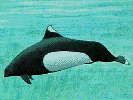
At up to 2.2 metres long and 220 kilograms, Dall's porpoises are the largest of the true porpoises. They are also the most like dolphins in their social habits. Ranging offshore and along the coasts in the North Pacific, they sometimes travel in dolphin-sized herds of up to 3,000. They have colonized literally the whole temperate North Pacific, and recent population estimates range from a few hundred thousand to more than two million.
Over the past few decades, however, Dall's porpoises have been killed in great numbers, mainly by Japanese fishermen. Salmon gill- netters using drift nets are accidentally snaring and killing thousands. In Japanese waters, fishermen harpoon the porpoises by hand from boats and small ships. Between 1986 and 1989, the number of recorded catches was more than 110,000. Poulation estimates for this area are not much higher.
Phocoendoides dalli
Size: 1.8 to 2.2 m, 135 to 220 kg
Calves at birth: 85 to 100 cm
Teeth: 19 to 28 teeth on each side of upper and lower jaws
Food: Fish (capelin, Pacific hake, Pacific and jack mackerel,
sardines, blennies and herring) and squid
Habitat: Deep water and close to shore
Range: Cooler waters of the North Pacific and Bering Sea
Status: Population unknown, but at least in the hundreds of
thousands
